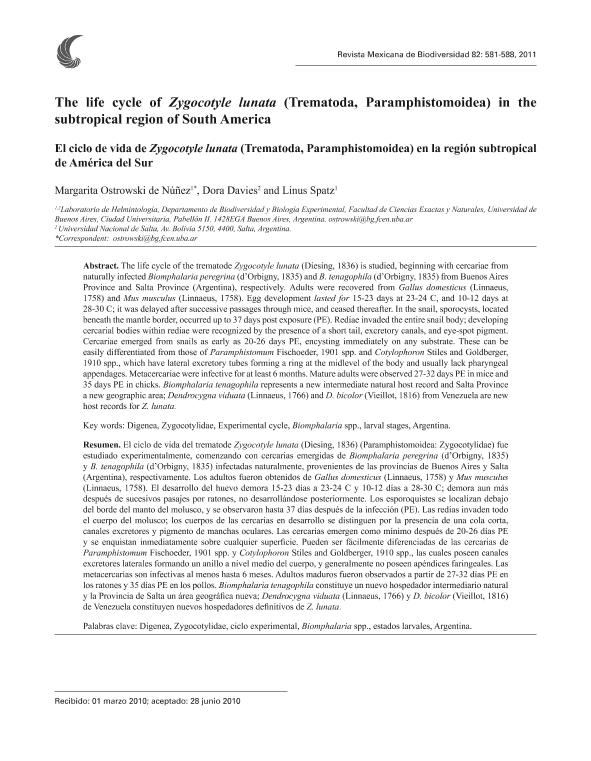Artículo
El ciclo de vida del trematode Zygocotyle lunata (Diesing, 1836) (Paramphistomoidea: Zygocotylidae) fue estudiado experimentalmente, comenzando con cercarias emergidas de Biomphalaria peregrina (d'Orbigny, 1835) y B. tenagophila (d'Orbigny, 1835) infectadas naturalmente, provenientes de las provincias de Buenos Aires y Salta (Argentina), respectivamente. Los adultos fueron obtenidos de Gallus domesticus (Linnaeus, 1758) y Mus musculus (Linnaeus, 1758). El desarrollo del huevo demora 15-23 días a 23-24 C y 10-12 días a 28-30 C; demora aun más después de sucesivos pasajes por ratones, no desarrollándose posteriormente. Los esporoquistes se localizan debajo del borde del manto del molusco, y se observaron hasta 37 días después de la infección (PE). Las redias invaden todo el cuerpo del molusco; los cuerpos de las cercarias en desarrollo se distinguen por la presencia de una cola corta, canales excretores y pigmento de manchas oculares. Las cercarias emergen como mínimo después de 20-26 días PE y se enquistan inmediatamente sobre cualquier superficie. Pueden ser fácilmente diferenciadas de las cercarias de Paramphistomum Fischoeder, 1901 spp. y Cotylophoron Stiles and Goldberger, 1910 spp., las cuales poseen canales excretores laterales formando un anillo a nivel medio del cuerpo, y generalmente no poseen apéndices faringeales. Las metacercarias son infectivas al menos hasta 6 meses. Adultos maduros fueron observados a partir de 27-32 días PE en los ratones y 35 días PE en los pollos. Biomphalaria tenagophila constituye un nuevo hospedador intermediario natural y la Provincia de Salta un área geográfica nueva; Dendrocygna viduata (Linnaeus, 1766) y D. bicolor (Vieillot, 1816) de Venezuela constituyen nuevos hospedadores definitivos de Z. lunata. The life cycle of the trematode Zygocotyle lunata (Diesing, 1836) is studied, beginning with cercariae from naturally infected Biomphalaria peregrina (d'Orbigny, 1835) and B. tenagophila (d'Orbigny, 1835) from Buenos Aires Province and Salta Province (Argentina), respectively. Adults were recovered from Gallus domesticus (Linnaeus, 1758) and Mus musculus (Linnaeus, 1758). Egg development lasted for 15-23 days at 23-24 C, and 10-12 days at 28-30 C; it was delayed after successive passages through mice, and ceased thereafter. In the snail, sporocysts, located beneath the mantle border, occurred up to 37 days post exposure (PE). Rediae invaded the entire snail body; developing cercarial bodies within rediae were recognized by the presence of a short tail, excretory canals, and eye-spot pigment. Cercariae emerged from snails as early as 20-26 days PE, encysting immediately on any substrate. These can be easily differentiated from those of Paramphistomum Fischoeder, 1901 spp. and Cotylophoron Stiles and Goldberger, 1910 spp., which have lateral excretory tubes forming a ring at the midlevel of the body and usually lack pharyngeal appendages. Metacercariae were infective for at least 6 months. Mature adults were observed 27-32 days PE in mice and 35 days PE in chicks. Biomphalaria tenagophila represents a new intermediate natural host record and Salta Province a new geographic area; Dendrocygna viduata (Linnaeus, 1766) and D. bicolor (Vieillot, 1816) from Venezuela are new host records for Z. lunata.
The life cycle of Zygocotyle lunata (Trematoda, Paramphistomoidea) in the subtropical region of South America
Título:
El ciclo de vida de Zygocotyle lunata (Trematoda, Paramphistomoidea) en la región subtropical de América del Sur
Fecha de publicación:
06/2011
Editorial:
Universidad Nacional Autónoma de México. Instituto de Biología
Revista:
Revista Mexicana de Biodiversidad
ISSN:
1870-3453
Idioma:
Inglés
Tipo de recurso:
Artículo publicado
Clasificación temática:
Resumen
Palabras clave:
DIGENEA
,
ZYGOCOTYLIDAE
,
CICLO EXPERIMENTAL
,
BIOMPHALARIA SPP
Archivos asociados
Licencia
Identificadores
Colecciones
Articulos(OCA CIUDAD UNIVERSITARIA)
Articulos de OFICINA DE COORDINACION ADMINISTRATIVA CIUDAD UNIVERSITARIA
Articulos de OFICINA DE COORDINACION ADMINISTRATIVA CIUDAD UNIVERSITARIA
Citación
Ostrowski, Margarita Clotilde; Davies, Dora Ana; Spatz, Linus; The life cycle of Zygocotyle lunata (Trematoda, Paramphistomoidea) in the subtropical region of South America; Universidad Nacional Autónoma de México. Instituto de Biología; Revista Mexicana de Biodiversidad; 82; 2; 6-2011; 581-588
Compartir
Altmétricas




